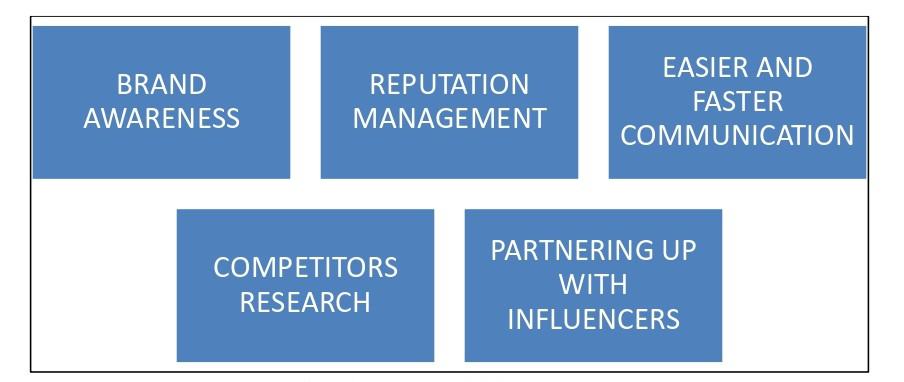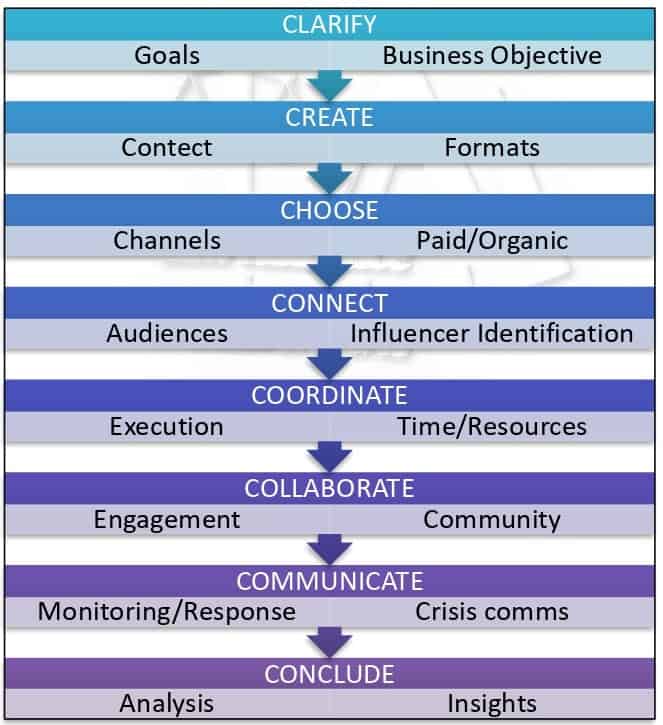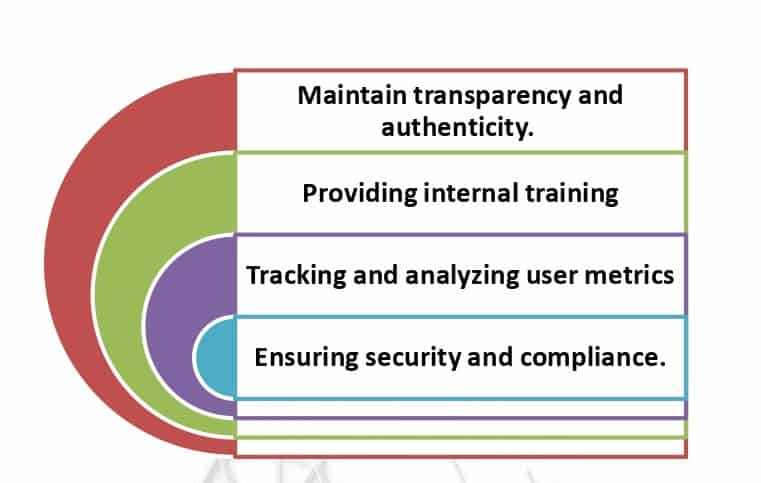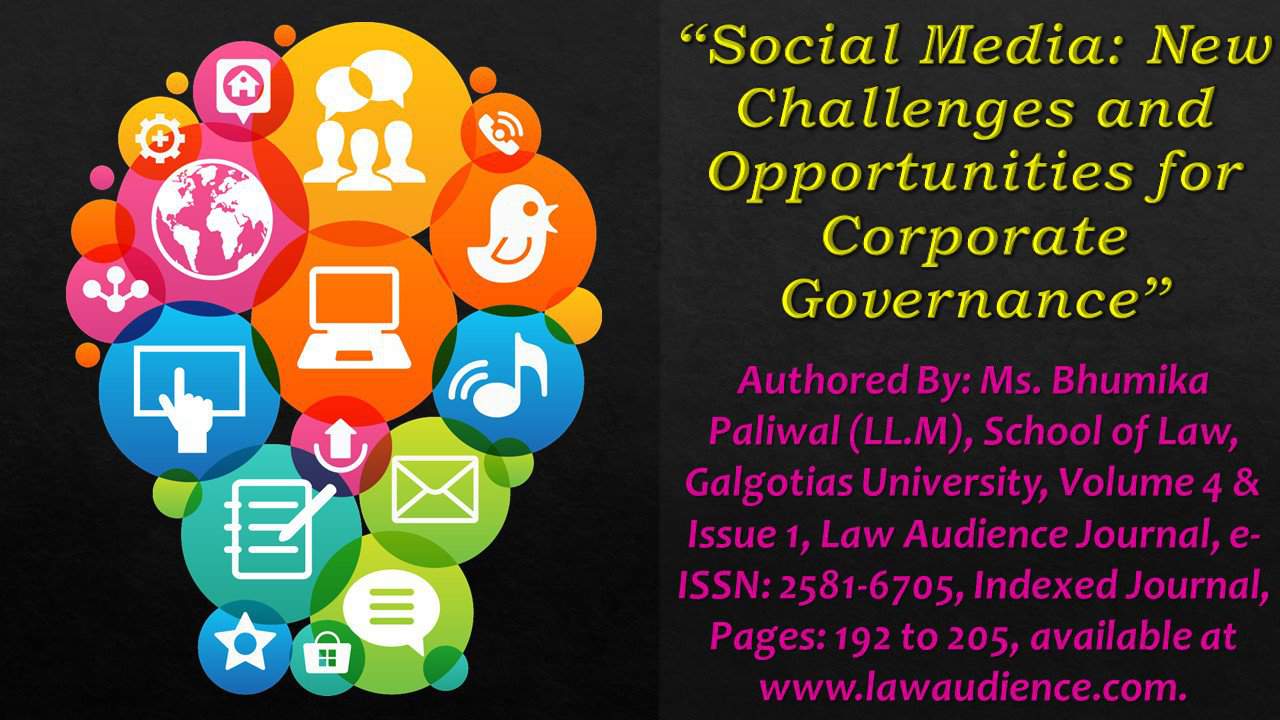Click here to download the full paper (PDF)
Authored By: Ms. Bhumika Paliwal (LL.M), School of Law, Galgotias University,
Click here for Copyright Policy.
ABSTRACT:
“Today social media plays a vital role in everyone’s lives. It is mostly used by each and every people either old or young in their both private and public lives every day. As these social networking sites help us to connect and interact with minded people. Although these networks were developed for the entertainment purpose of individuals instant response and sharing of information aspects of these sites are considered a good source for corporate communication. Social media becomes an extension of real-world communication strategies by allowing enhanced transparency and increasing interaction between companies and their stakeholders.
So, with the help of this paper, we will try to find out about the various sources of social media which affect the growth of corporate governance. Also, what challenges and opportunities it provides to corporate sectors and explained precautions can be taken by companies to use social media for the better corporate governance practices”.
Keywords: Corporate Governance, Social Media, Stakeholders, Facebook, Instagram, Twitter.
I. INTRODUCTION:
Social media serves as a dynamic, and differentiating, method for business communication. From accessible and scalable publishing leveraging web-based technologies to enabling interactivity rather than one-directional communication between employees, customers, partners, and investors (through blogs, social networking platforms, podcasts, third-party internet-based forums, wikis, and sites that host photos, videos or other user-generated content), social business is both mainstream and integral to individual and business success.[1] Social Media is not enough to drive business growth. Social platforms can help you connect with your customers, increase awareness about your brand, and boost your leads and sales. But you need to start with an always-on mindset and a solid content marketing strategy. It is an essential piece of your business marketing strategy. With more than three billion people around the world using social media every month, the users and engagement on major platforms just keep increasing. Social media provides immense potential for businesses because consumers habitually log on to it daily and are exposed to companies. It also presents huge challenges for businesses, however, because it’s an ever-changing space that is extremely noisy and crowded.[2]
According to the latest report of Statista in January 2022, the most popular social network with a number of monthly active users is:
- Facebook (2910 million users)
- YouTube (2562 million users)
- WhatsApp (2000 million users)
- Instagram (1478 million users)
- Telegram (550 million users)
- Pinterest (444 million users)
- Twitter (436 million users)
Points To Be Remember:
- The latest social media statistics show that there are 78 billion social media usersworldwide in 2021.
- The latest social media statistics in 2021 show that an average of two hours and 25 minutesare spent per day per person on social media.
- In a 2021 HubSpot Blog poll of 1,000+ global marketing professionals, 79% of marketers report buying paid advertising on social media.
- According to the same poll, 85% of marketers rank short-form videos as the most effective type of social media content in 2021.
- 64% of marketers plan to invest more in the short-form video in 2022.
- 83% of marketers believe the quality of social media posts is more important than the quantity.
- 54% of social browsers use social media to research products.[3]
“Social media provides targeting capability, as well as reach and scale, at a lower cost than almost all other marketing channels,” said Abdul Muhammad, Chief Digital Officer and Partner at RBB Communications, in a previous Business News Daily interview. “People are on social media all day, every day – brands must go where the people are.”
I.I WHAT IS SOCIAL MEDIA?
Social media is considered as any digital space where people from different cultures, places and backgrounds come together to communicate and interact with others. It is a platform where people create, share or exchange information and ideas in virtual communities and networks. Social media is an internet-based system which gives users a quick electronic response to any communication, providing documents, videos or any other personal information.[4] It covers a wide range of various websites and apps. Some of them are included Facebook, Instagram, Twitter, and YouTube etc., Facebook and Instagram are specialized in sharing videos and photos while others like Twitter is specialized in sharing links and short written messages.[5]
The users who want to use social media need to make an account on that platform. Any user who wants to sign in to their account on social media apps and websites needs to have internet access. The users having an account on social media platform can use it to share content whatever they want to in the form of photos or videos, or whatever content they choose to share reaches to anyone whoever visits their profile or pages.[6] According to the Pew Research Center, social media users tend to be younger. Nearly 90% of people between the ages of 18 and 29 used at least one form of social media. Further, these users tend to be better educated and relatively wealthy, or earning over $75,000 per year.[7]
I.II WHAT IS ENTERPRISE SOCIAL MEDIA?
Nowadays implementation of social media technology is vastly increasing and almost all organizations are adopting these technologies to facilitate many activities like communication, collaboration and co-creation. Enterprise social media mainly deals with the two ways of interaction in the organizations. The First way, involves communication with external stakeholders including customers, suppliers, and the public at large. On the other hand, another way involves communication with internal sources usually through proprietary outsourced or in-house platforms—between managers and employees as well as among employees.[8] Externally, many social media sources like Instagram, Facebook, Twitter and many other apps help an organization to stay close with their customers and conduct research to improve business processes and operations. While internally, these social tools help their employees by providing knowledge and resources they need to work together effectively and solve business problems.[9]
I.III WHAT IS CORPORATE GOVERNANCE?
Corporate governance is something altogether different from the daily operational management activities enacted by a company’s executives. It is a system of direction and control that dictates how a board of directors governs and oversees a company.
I.III.I OECD OFFICIAL DEFINITION OF CORPORATE GOVERNANCE IN BUSINESS:
The purpose of corporate governance is to help build an environment of trust, transparency and accountability necessary for fostering long-term investment, financial stability and business integrity, thereby supporting stronger growth and more inclusive societies.
I.III.II PRINCIPLES OF CORPORATE GOVERNANCE:
While corporate governance structure may vary, most organizations incorporate the following key elements:
- All shareholders should be treated equally and fairly. Part of this is making sure shareholders are aware of their rights and how to exercise them.
- Legal, contractual and social obligations to non-shareholder stakeholders must be upheld. This includes always communicating pertinent information to employees, investors, vendors and members of the community.
- The board of directors must maintain a commitment to ensure accountability, fairness, diversity and transparency within corporate governance. Board members must also possess the adequate skills necessary to review management practices.
- Organizations should define a code of conduct for board members and executives, only appointing new individuals if they meet that standard.
- All corporate governance policies and procedures should be transparent or disclosed to relevant stakeholders.
I.IV OBJECTIVE OF THE STUDY:
The main objective of this research study is as follows:
- To know about the opportunities which social media provide to corporate governance.
- To about the challenges and risks faced by companies due to the use of social media.
- To know about the various social networks which are used by the organizations.
- To know about the role of social media in applying social governance in the organization.
- To know the social media policy can be used by the company.
II. POPULAR SOCIAL-MEDIA TOOLS AND NETWORKS:
II.I FACEBOOK:
Facebook is considered as the most popular and largest social media site in the world with nearly 2.75 monthly users. It is ensuring that almost users regularly visit and use the platform. Facebook took very less time to grow it take nearly only 8 months to reach millions of followers while only 8 years to reach billions of followers. According to the report of Dreamgrow, almost 5,00,000 people become new users daily and 6 new users in every second. Having a large number of active users making it a vital platform for small business sales and social media marketing. Most organizations to promote their products use Facebook by makes official business pages and these business pages can connect you with customers and offer key information about your business, products, services, and upcoming events. Advertisements which arise during the usage of Facebook and messenger are highly targeted and effective ways to reach potential customers.
According to the report of HubSpot,
- 79% of marketers report buying paid advertising on Facebook and more than 50% of marketers plan on increasing their investments in Facebook in 2022.
- Video ads perform better than other ad formats on Facebook.
- Facebook ads are used by 70% of marketers, and there were 10 million active advertisers on the platform in Q3 2021.[10]
- 81% of businesses prefer video marketing on Facebook.
II.II TWITTER:
Twitter is considered as a good platform for the market strategy. It is a well-known social network in today’s time having more than 145 active users daily. To survive on this platform, one should need to win the attention of their audience with almost 500 million tweets every day. It’s a gold mine of customer insights and opportunities to build your brand, drive sales and win fans. The popularity of this social media site remains high amongst tech-savvy users and is particularly active in B2B verticals related to business, marketing and politics today.
According to the report of HubSpot,
- In a poll of 1,000+ global marketers, 79% of marketers plan to continue investing in Twitter Spaces in 2022.
- The best times to post on Twitter are Wednesday and Friday at 9 AM, and Saturday has the least engagement. [11]
- Tweets with hashtags get 100% more engagement.
- Socially responsible ads on twitter perform 12% better than standard ads.
- 93% of Twitter community members are open to brands getting involved in the conversation, such as providing help and support.
One Should Prioritize Twitter if its audience skews toward the demographic of mature males between the ages of 30 and 60.
II.III INSTAGRAM:
Instagram is the second most used social network behind Facebook. It consists of almost 1 billion monthly users and 500 million daily Instagram Stories. It involves influencers, brands, bloggers, small business owners, friends and everyone in between. The potential reach of Instagram marketing has grown substantially this year—increasing by 76 million people in just the last quarter. According to a report on Instagram, 90% of people on Instagram follow at least one business. It’s not just consumer products that benefit. More than 36% of B2-B decision-makers use Instagram when researching new products or services. Among which two of three people surveyed say Instagram enables interaction with brands and 50% are more interested in a brand when they see ads for it on Instagram. It can be said that in today’s time Instagram is not only used for personal purposes but It’s now a global platform that allows brands to humanize their content, recruit new talent, showcase products, and inspire their audience.
According to the report of HubSpot,
- In a 2021 poll, 58% of marketers plan to leverage Instagram Reels in 2022.
- 64% of Instagram users are under the age of 34.
- 98% of marketers say Instagram is the most influential platform for influencer marketing, which is 44% higher than Facebook.[12]
- Videos get 21.2% more interactions compared to images and 18.6% more interactions compared to carousels.
- 83% of people use Instagram to discover new products and services and 87% said they took specific action, like making a purchase, after seeing product information.
- In a 2021 poll of 1,000+ global marketers, 73% of marketers prefer Instagram for influencer marketing.
- eMarketer estimated that Instagram added 26.9 million users between 2016 and 2020 — almost double the incremental users expected for Twitter, and far more than any other social platform tracked.
II.IV YOUTUBE:
YouTube is considered the second most popular search engine in the world today behind Google. If your business could benefit from producing video tutorials or walkthroughs, visually-driven instructional content, product reviews or interviews, then this social media platform is a must for reaching their more than 2 billion monthly users. YouTube can help improve your SEO and overall brand presence. YouTube allows marketers to present unique content that’s easy for viewers to consume and share.
According To The Report of HubSpot,
- The number of YouTube users is projected to reach 2.8 million by 2025.
- In a 2021 poll of 1,000+ global marketers, 44% of marketers plan to leverage YouTube for the first time in 2022.
- 54% of all people want marketers to put out more video content, and this is an excellent place to begin.
- 18-to-34-year-olds use YouTube to view video content on TV, 7.9% more often than basic cable, and 14.5% more often than premium cable.
- One Should Prioritize YouTube if their audience is below the age of 50 and consumes video content as a means of either education or entertainment.
One Should Prioritize YouTube if its audience is below the age of 50 and consumes video content as a means of either education or entertainment.
III. OPPORTUNITIES SOCIAL MEDIA PROVIDE IN CORPORATE SECTORS:

III.I BRAND AWARENESS:
According to our previous study, we found that more than half of the population are using social media through various networks like Facebook, Instagram, Twitter etc. These are the places where users naturally reach to various new pages and discover new brands which were not in their knowledge. So, with the help of these social sites companies can reach to various users by promoting their brand throw advertisements and sponsorships it may help the organization to improve their brand awareness so, that the people who are not aware about these new brands can get in touch with these products.
III.II REPUTATION MANAGEMENT:
If any customer engages with any brand, then it leads them to increase their expectation with that brand but what if the organization is not able to satisfy their needs, then it leads to a bad experience for that organization. Bad And Good Experiences are the part of life but if the management is able to handle these situations by promoting and sharing great content is one way a brand can attract people, as well as keep them loyal to the brand, but that being likeable is only going to go so far. Lines of communication are simplified and kept as formal or informal as either party deems. Customers just want to be treated fairly and properly. Social media gives us a simple way to achieve that.
III.III EASIER AND FASTER COMMUNICATION:
Social Media makes communication easier and faster for the customers as it is only one click to contact the customer service centre. Also, through the mode of social media a customer can easily share their opinion about the products or businesses can also receive, review, and respond to customers’ grievances faster and easier than ever before. Customers can now communicate real feedback in real-time via reviews and chat, something businesses have strived to achieve for a long time. It’s only becoming easier as more people and brands use social media platforms to keep in contact with the people that matter most to their business.
III.IV COMPETITOR’S RESEARCH:
Today most in every second brand uses social media to promote or sell their brand so it’s become easy to know that what are the new brands launched in the market and who are the new competitors arise in the market. Also, we can get to learn most of the things from our competition because it’s never late to learn anything from anyone. Also, we can keep an eye on our competitors’ actions it will help us to keep up to date in the market.
III.V PARTNERING UP WITH INFLUENCERS:
Social Media help us to build and maintain a relationship with almost social media influencers. From jobs, friendships, partnerships, volunteer organizations, and most anything else that requires teamwork and the collective power of that team, social media has made it that much easier to maintain and develop real relationships. Influencers have emerged as a breed of brand ambassadors who usually use social media platforms and have a large number of following on social media and draw the attention of that following to your brand. These Influencers also give their reviews to these products which make customers more satisfy to purchase that product.
V. SOCIAL MEDIA RELATED REGULATION IN DIFFERENT SECTORS:

IV.I ROLE OF SOCIAL MEDIA IN CORPORATE GOVERNANCE:
Social media came as a most beneficial and powerful social network for the businesses. It enhances the reputation of companies, provide many opportunities to stakeholders, decrease the communication gap between employers and customers, help in build the brand awareness and be an effective tool to promote businesses.
IV.II ROLE OF SOCIAL MEDIA FOR BOARD OF DIRECTORS:
Now when social media became an integral part of our life mostly companies are become dependent on these platforms only for collecting data related to their brand and incorporating them into corporate strategy, operational plans, and risk management. Those who do rely on this information find it useful in pursuing corporate objectives. On the basis of these data now companies can make an actionable plan to implement for corporate decision making. The directors and executives assume that there is a potential impact of social media on marketing, branding, reputation management, and customer outreach.
IV.III ROLE OF SOCIAL MEDIA IN INTERNAL AUDIT COMMITTEES:
The internal audit committee provide whole view of working of social media. It reviews the whole process to know about the current social media strategy. These internal audits can include impressions, comments, likes, shares, and other interactions, as well as which posts are getting the most engagement and what audience is doing the most engaging. These data which provided by this committee can help a company the make usage of social media more effectively.
IV.IV ROLE OF SOCIAL MEDIA TO EMPLOYEES FOR APPLYING GOOD CORPORATE GOVERNANCE:
A good team of members make a working of an organization easier and faster. A responsible person always pointed out the mistake of their colleague no matter in which post they are. An employee should be alerted enough to point out the wrong doings of his superior. Abuse of social media between employees and their superiors which cross the boundaries between professional and personal work can directly impact the reputation of the company.
IV.V ROLE OF SOCIAL MEDIA TO GOVERNMENT AND OTHER LAW-MAKING AGENCIES:
The companies act 1956, provide legislation and acts in the form of many rules and regulation which are officially implemented by the government to make corporate sector more accountable and their working more transparent. now, it is the duty of companies to implement these acts but if any company do not perform according to these acts than government may emphasis the bad practices done by companies through social media.
IV.VI ROLE OF SOCIAL MEDIA IN PROTECTING STAKEHOLDERS:
Because of their format, targeting abilities, and structure, social media‐based communication strategies are an effective extension of a company’s existing shareholder outreach.
VI. SOCIAL MEDIA STRATEGY FOR CORPORATE SECTORS: CHALLENGES/RISKS ARISE IN THE CORPORATE SECTOR DUE TO SOCIAL MEDIA:
VI.I PRIVACY/SECURITY:
Many social media platforms still get hacked from time to time despite having good security measures in place. Some also don’t offer all the privacy options that users need to keep their information as private as they want them to be.
VI.II INFORMATION-OVERLOADED:
It’s not unusual to have over 200 Facebook friends or follow over 1,000 Twitter accounts. With so many accounts to follow and so many people posting new content, it’s almost impossible to keep up.
VI.III TURNING EMPLOYEES INTO BRAND ADVOCATES:
One of the easiest ways to turn your employees into brand advocates is to make it easy. We recently launched Bambu, an employee advocacy platform that makes it easy for companies to curate content for employees or brand ambassadors to share with their social networks. It’s a great way to streamline the important messages and content that matter to your brand.
VI.IV KNOWING WHICH SOCIAL MEDIA PLATFORM TO USE:
Every social media platform has its own advantage and its own customers. it makes companies really confused to choose their correct network to for the purpose of brand building. You need to familiarize yourself with the demographics for each social network and see if your target audience is among them. It’s not enough to know where they are; you need to know where they’re active.
VI.V HAVING A HUMANISTIC RELATIONSHIP WITH YOUR CUSTOMERS:
Social media is a great way to build awareness and attract new customers, but you have to think about what you’ll do to retain them. While 86% of social media users follow a brand, almost 60% of them are annoyed with too many promotions. You can’t always be selling. In order to increase brand loyalty, you need to focus on developing a rewarding, humanistic relationship with your audience.
VII. SUGGESTIONS FOR EFFECTIVE SOCIAL MEDIA GOVERNANCE:

VIII. CONCLUSION:
Now, in the modern world, social media is considered as the most important tool for companies. Even if you want to avoid it you can’t. Yes, there are many risks available in it but ignoring them is no longer an option. The days of one-sided communication are long gone. Instead, we now have a continuing two-way conversation with traditional stakeholders and the community at large, including technology-savvy people who know how to shape and dominate public discourse.
Cite this article as:
Ms. Bhumika Paliwal, “Social Media: New Challenges and Opportunities for Corporate Governance”, Vol.4 & Issue 1, Law Audience Journal (e-ISSN: 2581-6705), Pages 192 to 205 (13th June 2022), available at https://www.lawaudience.com/social-media-new-challenges-and-opportunities-for-corporate-governance/.
Footnotes & References:
[1] Mark Hewitt, Social business is an essential professional core skill(September 12, 2019) https://www.thedigitaltransformationpeople.com/channels/customer-engagement/social-business-is-an-essential-professional-core-skill/
[2] https://marketinginsidergroup.com/content-marketing/why-social-media-is-important-for-business-marketing/
[3] report GlobalWebIndex
[4] https://communications.tufts.edu/marketing-and-branding/social-media-overview
[5] https://www.thebalancesmb.com/what-is-social-media-2890301
[6] ibid
[7] Pew Research Center. “Social Media Fact Sheet, https://www.pewresearch.org/internet/fact-sheet/social-media/ ” Accessed Oct 31, 2021.
[8] http://www.drvanosch.com/wp-content/uploads/VanOschSteinfieldBaloghHICSS2015.pdf
[9] https://www.techtarget.com/searchcio/definition/enterprise-social-networking
[10] Social Media Examiner , Statista




